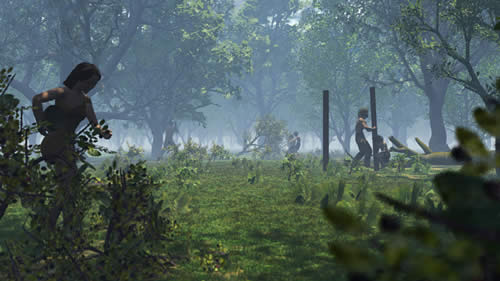- This website reflects our views on the Terminal 5 site based on many years of post-excavation analysis, which culminated in the publication of the final volume of the T5 report in 2010.
The Heathrow Landscape
How do we know this?
Find out more details in our archaeological evidence sectionHeathrow Airport
The Archaeologists
Framework Archaeology
Tag Archives: clearing
4,200-3,600 BC A Clearing in the Woods

People working to extend a clearing in the woods, during the Neolithic
Neolithic Clearance
The introduction of agriculture around 4,000 BC seems to have little impact on the landscape, at least at first. However, around 3,700 BC the combination of human activity and Dutch Elm Disease led to a dramatic decline in the proportion of elm trees in the forest. It is likely that disease would lead to the opportunity for people to clear patches of dead or non-viable elms. The labour required for cutting down and uprooting mature trees is considerable, and this opportunity to create clearances in the forest would have required the different family groups to come together and co-operate on a formal basis. This act of labour would have strengthened the bonds between the families, and led over time to the creation of clearings for more extensive grazing of domesticated animals and the growing of crops. How the families responded to the opportunity presented by the elm decline had a direct effect on the landscape, but also the indirect effect of starting to build a stronger community. From now on, the family groups had to negotiate who, how and where they would exploit not only the natural resources of the landscape, but also the important clearings that they had created. One of the mechanisms they employed to do this was to elaborate the oral and ritual traditions of the past into ceremonies, and then to place those ceremonies within an architectural context. For instance, at two locations along the edge of the Colne floodplain were a series of timber posts, which may have functioned as totem poles. It is likely that each family group had a particular location or locations which were historically important to them, such as the Mesolithic bunt flint pits, where they hosted meetings and ceremonies for the leading members of the other family groups. It is possible that the ceremonies involved processing from place to place, and just such a route way seems to have linked the string of small monuments and settlements along the edge of the Colne floodplain. The remains of one possible settlement were found under the alignment of the later Stanwell Cursus at Heathrow.
